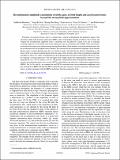Recombination-amplitude calculations of noble gases, in both length and acceleration forms, beyond the strong-field approximation
Author(s)
Bhardwaj, Siddharth; Son, Sang-Kil; Hong, Kyung-Han; Lai, Chien-Jen; Santra, Robin; Kaertner, Franz X.; ... Show more Show less
DownloadBhardwaj-2013-Recombination-amplitude.pdf (353.0Kb)
PUBLISHER_POLICY
Publisher Policy
Article is made available in accordance with the publisher's policy and may be subject to US copyright law. Please refer to the publisher's site for terms of use.
Terms of use
Metadata
Show full item recordAbstract
Transition of an electron from a free to a bound state is critical in determining the qualitative shape of the spectrum in high-order-harmonic generation (HHG), and in tomographic imaging of orbitals. We calculate and compare the recombination amplitude, from a continuum state described by a plane wave and an outgoing scattering eigenstate, to the bound state for the noble gases that are commonly used in HHG. These calculations are based on the single active electron model and the Hartree-Fock-Slater method, using both the length form and the acceleration form of the dipole matrix element. We confirm that the recombination amplitude versus emitted photon energy strongly depends upon the wave function used to describe the free electron. Depending on the choice of the wave function and the dipole form, the square of the absolute value of the recombination amplitude can differ by almost two orders of magnitude near the experimentally measured Cooper minima. Moreover, only the outgoing scattering eigenstates with the length form roughly predict the experimentally observed Cooper minimum for Ar (~50eV) and Kr (~85eV). We provide a detailed derivation of the photorecombination cross sections from photoionization cross sections (PICSs) calculated by the relativistic random phase approximation (RRPA). For Ar, Kr, and Xe, we compare the total PICSs calculated using our recombination amplitudes with that obtained from RRPA. We find that PICS calculated using the outgoing scattering eigenstates with the length form is in better agreement with the RRPA calculations than the acceleration form.
Date issued
2013-11Department
Massachusetts Institute of Technology. Department of Electrical Engineering and Computer Science; Massachusetts Institute of Technology. Research Laboratory of ElectronicsJournal
Physical Review A
Publisher
American Physical Society
Citation
Bhardwaj, Siddharth, Sang-Kil Son, Kyung-Han Hong, Chien-Jen Lai, Franz X. Kärtner, and Robin Santra. “Recombination-amplitude calculations of noble gases, in both length and acceleration forms, beyond the strong-field approximation.” Physical Review A 88, no. 5 (November 2013). © 2013 American Physical Society
Version: Final published version
ISSN
1050-2947
1094-1622